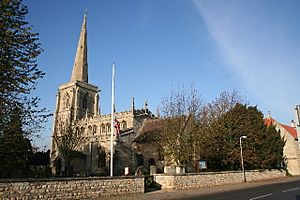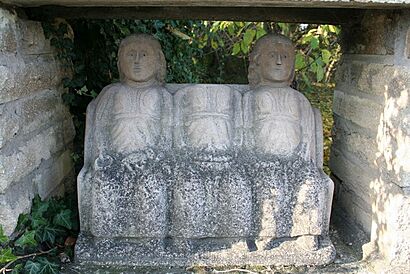St Martin's Church, Ancaster facts for kids
Quick facts for kids St Martin's Church, Ancaster |
|
|---|---|

St Martin's Church, Ancaster
|
|
| 52°58′50″N 0°32′16″W / 52.9805°N 0.5378°W | |
| Country | United Kingdom |
| Denomination | Church of England |
| History | |
| Dedication | St Martin |
| Administration | |
| Parish | Ancaster and Wilsford |
| Deanery | Deanery of Loveden |
| Diocese | Diocese of Lincoln |
| Province | Canterbury |
St Martin's Church is a very old and important church in Ancaster, a village in Lincolnshire, England. It is dedicated to Martin of Tours, a famous saint. This church is a "Grade I listed" building, which means it's a really special historical place.
You can find St Martin's Church about 6 miles (10 km) north-east of Grantham. It sits near an old Roman road called High Dyke, which was part of Ermine Street. The church is part of the Church of England and serves the communities of Ancaster and Wilsford.
Contents
History of St Martin's Church
Early Beginnings
Long, long ago, around the year 1086, there were already churches near Ancaster. The Domesday Book, a very old record, mentions two churches in the area. There was also a small chapel dedicated to St Mary nearby.
Changes Over Time
The church's official records, called a parish register, started in 1722. Over the years, the church has had many updates. In 1859, the main part of the church, called the nave, was repaired and given a new floor. Later, in 1912, the church's tall tower was also fixed up.
Around 1898-1899, the church organ (a musical instrument) and the font (a basin for baptisms) were moved to new spots inside the church. In 1909, the churchyard, where people are buried, was closed for new burials, except for special family graves.
Architecture and Design
Church Layout
St Martin's Church is big enough for 220 people to sit inside. It is built from local Ancaster stone. The church shows different building styles from history, including Norman, Early English, and Decorated designs.
The church has several main parts:
- The chancel (the area around the altar).
- The nave (the main part where people sit).
- North and south aisles (passageways on the sides).
- A tall tower with a spire (a pointed top) at the west end.
- A south porch (an entrance area).
Tower and Roof Details
The church tower is made of smooth stone and has five bells inside. It has battlements at the top, which look like the walls of a castle. The spire has three levels of small windows called lucarnes.
The roof has decorative parapets (low walls) with pointed decorations called pinnacles and carved figures called gargoyles. The tops of the buttresses (supports on the outside walls) also have interesting grotesque figures. Inside the nave, there are windows high up, called clerestory windows, which date back to the 1400s.
Inside the Church
The north side of the nave has a beautiful arcade (a row of arches) from around 1160-1170. It has round piers (columns) and arches with detailed carvings. The south arcade is from the Early English period.
The south aisle has very fancy Perpendicular battlements and pinnacles. The font is from the 1100s, and the south doorway has a special three-leaf shape called a trefoil. The arch leading to the tower is in the Decorated style, and the roof has carved figures attached to it.
Stained Glass and Memorials
The church has beautiful stained glass windows. Four windows in the chancel and two at the west end were given by F. W. Affix. Other memorial windows were added in 1880 and 1904 to remember people like Lucy Anderson Lloyd and Marjorie Stote. There is also a window from the late 1200s with a round, four-leaf shape called a quatrefoil.
Inside the church, you can see many monuments and plaques. In the north aisle, there's a tablet for Elizabeth Long (who died in 1743) with a trumpeting angel. Another monument, by King of Bath, is for John Roe (who died in 1796) and features a standing woman. In the chancel, there are plaques from the 1800s for the Allix family. The church also has an old silver cup, called a chalice, from around 1770.
Ancient Discoveries
In the church porch, you can see two old stone effigies (sculptures of people), one from the early 1300s. In the churchyard, there are several stone coffins.
Close to the church, you can find even older Roman sculptures. These include carvings of the "Dew Matres" (ancient mother goddesses), a small altar, and a Roman milestone from the time of Constantine the Great (who was emperor from 306 to 337 AD). These show how long people have lived and worshipped in this area!


